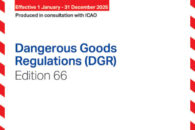
Geoff Leach is a consulting partner and was the former Head of the UK CAA Dangerous Goods Office and Chairman of the ICAO Dangerous Goods Panel. After 32 years at the CAA, in 2014, he set up The Dangerous Goods Office Limited offering training and consultancy around the world.
By Geoff Leach
One of the consequences of an enforced downtime is that one tends to watch more television then they would normally. In a former life, before I discovered the wonders of dangerous goods, I was the editor of the World Airline Accident Summary, then produced by the UK Civil Aviation Authority, and retain an interest in the investigation of aviation accidents. This week I watched an episode of National Geographic’s Air Crash Investigation series, which detailed an accident nearly 30 years ago and which got me thinking about a comparison with another, more recent accident, which will be well known to dangerous goods specialists.
Two Incidents with Unforeseen Connections
On 8 September 1989, a Convair CV 580 aircraft operated by Partnair departed from Fornebu airport in Oslo for a flight to Hamburg. Whilst in the cruise at 22,000 feet the aircraft suffered a severe vibration in the area of the tailplane and the vertical fin separated which subsequently caused the aircraft to disintegrate. All 50 passengers and 5 crew lost their lives. A little over 20 years later, on 3 September 2010, UPS flight 6 departed Dubai airport en-route to Cologne. Approximately 20 minutes into the flight, the crew received warning of an on-board fire and an attempt was made to return to Dubai. Sadly, this was unsuccessful, and the aircraft crashed with the loss of both pilots.
Two fatal aircraft accidents, one due to a catastrophic airframe failure, the other due to an uncontrollable in-flight fire, so what could possibly connect these accidents?
Investigation of the Partnair accident revealed the vibration which caused the fin to separate was due to excessive wear in the pins (bolts) which attached the fin to the aircraft. Further analysis of the pins revealed them to be bogus parts (i.e. counterfeit), with little more than 50% of the strength of a genuine part. In the case of UPS flight 6, whilst an uncontrollable inflight fire caused the loss of the aircraft, the cause of the fire could not be definitively established but investigation of the cargo revealed the presence of significant quantities of substandard lithium ion batteries. The extent to which these played a part in the accident, i.e. whether they caused the fire or contributed to the fire, started from an unrelated source will never be known.
In both accidents, counterfeit/substandard items were involved to varying degrees. The fact that some were part of the aircraft whilst others were carried as cargo is immaterial, both accidents prove that there are unscrupulous companies prepared to manufacture items purporting to comply with requirements when they did not. One would think, therefore, that strong enforcement action would be taken against such entities. That was certainly the case in the Partnair accident, with the Federal Aviation Administration (FAA) tracking down and prosecuting a number of those entities.
Do We Hold Counterfeiters Accountable?
Staggeringly, it was reported that up to 95% of parts in the inventory of some parts brokers were counterfeit! The same cannot be said for UPS flight 6; as far as I am aware, and I am open to correction, no shipper of the substandard batteries was ever held to account. So why was this? Well, UPS flight 6 was an American registered aircraft operating between the United Arab Emirates and Germany, whereas the batteries were manufactured in China, presenting jurisdictional issues. But similar conditions applied in the Partnair accident; it involved a Norwegian registered aircraft operating between Norway and Germany, but the offending items were made in the US. So why the difference in enforcement actions? Was it because UPS flight 6 was a freighter with the loss of only the 2 crew members? I sincerely hope not, I get very angry when some suggest that cargo aircraft and the lives of those onboard should somehow be viewed as less important than a passenger aircraft; those who may hold that view would do well to read the report on the El Al Boeing 747 freighter that crashed on 4 October 1992 in the city of Amsterdam to see what collateral damage may also occur from a crash involving a freighter.
The different level of enforcement is more to do with the fact that the items in the Partnair accident were manufactured within the aviation system and were subject to prescribed manufacturing standards. Furthermore, the producers and sellers of such items are traceable. The same cannot be said for lithium batteries; sure, we have the very stringent requirements of the UN, ICAO and IATA including the testing according to Section 38.3 of the UN Manual of Tests and Criteria. But the 38.3 tests relate to classification, not manufacturing, and consequently the problem of substandard and counterfeit lithium batteries cannot be solved by the aviation industry – no amount of additional aviation requirements and legislation can fix the issue of substandard/counterfeit batteries – it requires a concerted effort by governments to develop and strictly enforce appropriate standards for the manufacture of lithium batteries.
It was recently suggested that more money is spent on the detection of fake high-end handbags than on detection of substandard and counterfeit lithium batteries. Until the governments of the world work collaboratively and give the issue the attention it deserves, the scourge of counterfeit and non-compliant lithium batteries will, I’m afraid, continue unabated.
Make sure your shipments are safe and in complete compliance with a full line of solutions from Labelmaster—a full-service provider of goods and services for hazardous materials and Dangerous Goods professionals, shippers, transport operators and EH&S providers.



Thank you for useful information
Excellent letter Geoff.
Is it too much to hope that the relevant authorities will read it & take action?
I suggest it should be given to all participants at the start of lithium battery training courses
GPC